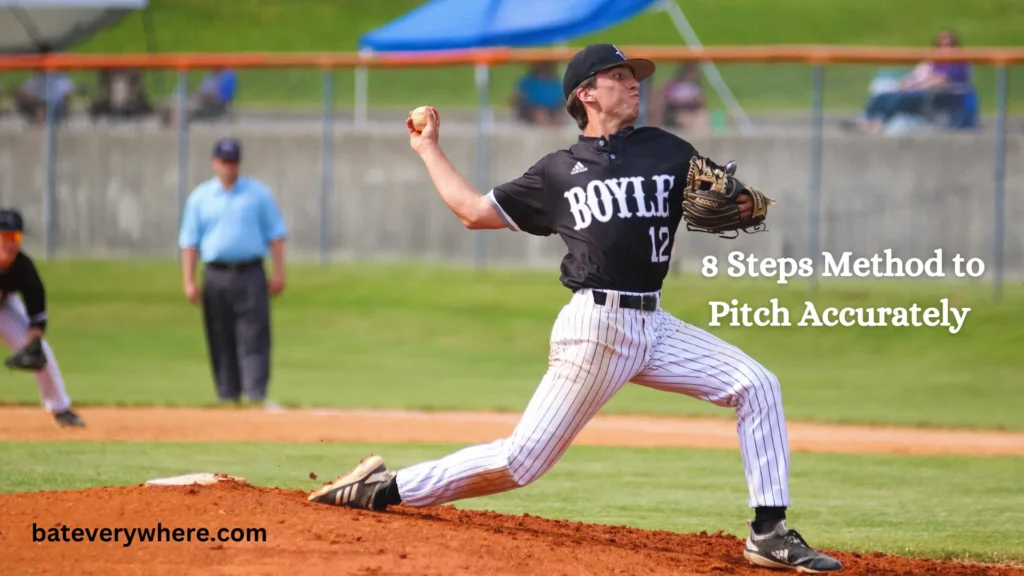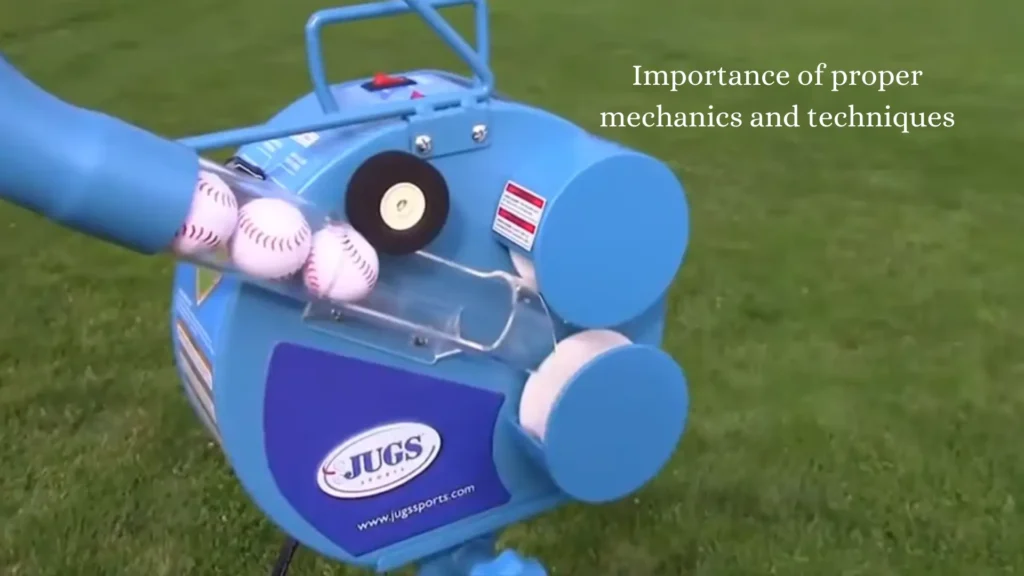
Are you ready to step up to the plate and become a master of pitching in baseball? Whether you’re a beginner just starting out or an experienced player looking to fine-tune your skills, this ultimate guide is here to help you dominate on the mound. Pitching is not only one of the most important positions in baseball, but it’s also an art form that requires precision, strategy, and mental toughness. In this comprehensive guide, we’ll explore everything from the different types of pitches and when to use them, to proper mechanics and techniques for maximum effectiveness. So grab your glove, tighten those cleats, and let’s dive into the world of pitching in baseball!
How to play pitcher
To play pitcher in baseball, you need to be able to throw the ball accurately and with speed. You also need to be able to control your pitches and throw them to different locations in the strike zone.
Here are the basic steps on how to pitch in baseball:
Get into your starting position: This is typically with your feet shoulder-width apart, your weight on your back leg, and your glove hand in front of your body.
Wind up: This is when you bring your pitching arm back and your glove hand forward.
Stride forward. As you stride forward, shift your weight to your front leg and raise your pitching arm up.
Stride forward: As you stride forward, shift your weight to your front leg and raise your pitching arm up.
Release the ball: As you release the ball, snap your wrist and follow through with your pitching arm.
What skills do I need to play pitcher?
Pitching in baseball requires a blend of arm strength, precise control, and a variety of pitch techniques. A pitcher’s success is tied to mastering mechanics, mental resilience, and adjusting to game dynamics. With a strong throwing arm and a diverse pitch repertoire, a pitcher aims for accuracy and strategic delivery. Each pitch, from fastballs to changeups, is a strategic move aimed at outwitting the batter. Through dedicated practice and a deep understanding of the game, a proficient pitcher can influence the game and guide their team to victory.
How important is the pitcher?
The importance of a pitcher in baseball cannot be overstated. The pitcher is the linchpin of the team, responsible for initiating each play and controlling the pace of the game. Their skill and performance directly impact the team’s success.
A skilled pitcher possesses not only physical prowess but also strategic intelligence, adaptability, and mental resilience. Their ability to throw a variety of pitches accurately, control the game’s tempo, and read the opposition’s hitters is pivotal. A great pitcher can shift the momentum of a game, keeping the team in a winning position. In essence, the pitcher’s role goes beyond physical talent; it embodies strategy, leadership, and the ability to rise to the occasion under pressure. They are the cornerstone of a team’s defense and a key player in determining victory on the baseball field.
How do you pitch accurately in baseball?
Pitching accurately in baseball involves a combination of proper mechanics, technique, mental focus, and practice. Here are steps and tips to improve pitching accuracy:
Grip and Hand Placement:
Learn and experiment with different grips for pitches (e.g., fastball, curveball, changeup). Grip variations affect the ball’s movement and speed.
Stance and Balance:
Maintain a balanced stance on the pitching rubber with your feet shoulder-width apart and weight evenly distributed. This sets a solid foundation for your pitch.
Proper Windup and Delivery:
Practice a consistent windup or stretch delivery to maintain rhythm and balance, essential for accurate pitching.
Focus on Target:
Keep your eyes on the target (usually the catcher’s glove) throughout the pitching motion to maintain accuracy and concentration.
Arm Action and Mechanics:
Develop a smooth and repeatable pitching motion, focusing on proper arm action, hip rotation, and follow-through for each pitch.
Release Point:
Ensure a consistent release point for each pitch, adjusting based on the type of pitch you’re throwing (high, low, inside, outside).
Practice Pitching Drills:
Incorporate drills to improve accuracy, such as hitting specific spots on the strike zone or using target markers.
Controlled Breathing:
Practice controlled breathing to stay calm and focused, especially in high-pressure situations.
Video Analysis:
Record and analyze your pitching technique to identify areas for improvement and make necessary adjustments.
Mental Preparation:
Develop mental toughness, confidence, and a positive mindset. Visualize successful pitches and focus on executing each one with precision.
Consistent Reps and Training:
Regularly practice pitching, aiming for consistency and quality in every repetition.
Receive Coaching and Feedback:
Seek guidance from experienced coaches who can provide valuable feedback and help refine your pitching mechanics and accuracy.
Remember, becoming an accurate pitcher takes time, dedication, and consistent practice. Pay attention to your mechanics, stay focused, and continuously strive to improve your skills to enhance your accuracy on the mound.
8 Pitching Accuracy Tips
Types of pitches and their characteristics
When it comes to pitching in baseball, one of the most crucial aspects is mastering different types of pitches. Each pitch has its own unique characteristics that can be used strategically to outsmart batters and keep them guessing.
fastball
The fastball is arguably the most commonly thrown pitch in baseball. It’s all about speed, as pitchers aim to throw the ball with maximum velocity towards home plate. Fastballs can reach speeds upwards of 100 miles per hour and are notorious for leaving batters struggling to catch up.
On the other end of the spectrum, we have off-speed pitches like changeups and curveballs. Changeups are designed to deceive batters by mimicking a fastball but with reduced velocity. The sudden change in speed can throw off a batter’s timing, making it difficult for them to make solid contact.
Curveballs
Another popular pitch is the curveball. This breaking ball requires a tight grip with fingers positioned along the seams, allowing for greater control over its movement. When thrown correctly, this pitch can deceive batters by appearing as if it will cross the strike zone before sharply dropping down.
Slider
Slider pitches combine elements from both fastballs and curveballs, resulting in a pitch that breaks laterally instead of vertically. This sideways movement makes sliders particularly challenging for batters as they try to determine whether it will stay within or outside the strike zone.
Changeup
This pitch is thrown with the same arm motion as the fastball, but with a slower speed and a different grip. This can be an effective pitch to deceive the batter and get them to swing and miss.
knuckleballs
There are specialty pitches like knuckleballs that defy convention altogether! Knuckleball pitchers intentionally minimize spin on their throws which leads unpredictable movements through air resistance acting upon raised seams on each side!
Each type of pitch requires specific techniques and grips depending on how you want your ball move! Mastery comes not just from understanding these nuances but also practice honing skills until consistently executed at desired level!
Choosing the right pitch for different situations
Choosing the right pitch for different situations is a crucial aspect of being a successful pitcher in baseball. Each situation calls for a specific type of pitch that can maximize your chances of getting the batter out or inducing weak contact. It requires careful analysis and understanding of both the game situation and the strengths and weaknesses of each pitch in your repertoire.
When deciding on which pitch to throw, you need to consider factors such as the count, baserunners, and the hitter’s tendencies. For example, if it’s an 0-2 count with no runners on base, you may want to go for an off-speed pitch or breaking ball to try and catch the batter off guard. On the other hand, if there are runners in scoring position with less than two outs, you might opt for a fastball or sinker to induce a ground ball double play.
It’s also important to take into account your own abilities as a pitcher. You should know which pitches you have better command over and which ones are more effective against certain types of hitters. Understanding your own strengths will help guide your decision-making process when choosing pitches.
Importance of proper mechanics and techniques

Proper mechanics and techniques are vital components for any pitcher looking to excel on the baseball field. These elements not only improve performance but also help prevent injuries.
First and foremost, mastering proper mechanics ensures that a pitcher is able to generate maximum power and accuracy with each throw. This involves maintaining good posture, utilizing a strong leg drive, and using the entire body in a coordinated motion. By following these principles, pitchers can effectively transfer energy from their legs through their core and into their throwing arm.
Additionally, having sound pitching techniques allows pitchers to consistently hit their spots and deceive batters with different pitch types. Whether it’s perfecting the grip on a curveball or fine-tuning the release point of a fastball, attention to detail in technique can make all the difference in confusing hitters and keeping them off balance.
Focusing on proper mechanics helps reduce stress on various joints in the body such as the elbow and shoulder. By aligning movements correctly, pitchers can minimize strain on these vulnerable areas which are prone to injury due to repetitive motions.
Establishing solid mechanics combined with effective techniques is crucial for success as a pitcher in baseball. It not only enhances performance but also minimizes the risk of injury. So aspiring pitchers should invest time and effort into honing these skills if they want to achieve their fullest potential on the mound!
Mental preparation for pitching success
Mental preparation is a crucial aspect of pitching success in baseball. It’s not just about physical prowess; it’s also about having the right mindset on the mound. Here are some key points to keep in mind for effective mental preparation:
1. Stay focused: One of the most important things for a pitcher is to maintain focus throughout the game. This means blocking out distractions and staying fully present in each pitch.
2. Visualize success: Before stepping onto the mound, visualize yourself throwing perfect pitches and executing your game plan flawlessly. This positive imagery can help build confidence and improve performance.
3. Develop routines: Establishing pre-pitch routines can help you stay calm and centered during high-pressure situations. Whether it’s taking a deep breath, adjusting your cap, or tapping the rosin bag, find rituals that work for you.
4. Control emotions: Baseball can be an emotional game, but as a pitcher, it’s essential to stay composed and level-headed at all times. By managing your emotions effectively, you’ll be better equipped to make smart decisions on the field.
5. Learn from mistakes: Every pitcher will face challenges and make mistakes at some point. Instead of dwelling on these setbacks, use them as learning opportunities to grow and improve your skills.
Remember that mental preparation is an ongoing process that requires practice and commitment. By working on these aspects of your game alongside physical training, you’ll be well-equipped to handle whatever comes your way on the mound!
is music is best for Mental preparation for pitching success?
Music can indeed be a powerful tool for mental preparation, including for pitching success. The right music can help you get into a focused and confident mindset, which is crucial for pitching effectively. Different people may find different types of music most helpful – some might prefer upbeat and energizing tunes to pump them up, while others might prefer calming music to help them relax and focus. Ultimately, it’s about finding what works best for you and using it to your advantage in preparing for your pitch.
Is pitching hard to play?
Is pitching hard to play? It’s a question that many aspiring baseball players ask themselves. The answer, like so many things in sports, is both yes and no.
On one hand, pitching can be incredibly challenging. It requires a unique set of skills and physical attributes. From the mechanics of delivering the ball to the mental toughness required to face opposing batters, there are many factors that make pitching difficult.
First and foremost, pitchers must have good control over their pitches. They need to be able to consistently throw strikes and locate their pitches where they want them to go. This takes years of practice and honing their craft.
pitchers need to develop an arsenal of different pitches. Each pitch has its own unique characteristics and purposes. From fastballs with varying speeds and movement to breaking balls that deceive hitters, pitchers must master multiple techniques.
Furthermore, pitching also demands mental strength and resilience. Pitchers often find themselves in high-pressure situations where every pitch counts. They need the ability to stay focused amidst distractions and maintain confidence even when things aren’t going well.
What does a pitcher do?
The role of a pitcher in baseball is crucial to the success of their team. A pitcher is responsible for throwing pitches with precision and strategy, aiming to outsmart the opposing batters and secure outs. They are the ones who set the tone for the game, dictating its pace and flow.
One of the primary tasks of a pitcher is to execute different types of pitches effectively. This requires mastering various grips, arm angles, and release points to produce movement on the ball. Each pitch has its own unique characteristics that can confuse hitters and make it challenging for them to make solid contact.
In addition to delivering pitches, a pitcher must also be aware of game situations and adjust their approach accordingly. They need to analyze each batter they face, considering their strengths and weaknesses, in order to select the most appropriate pitch sequence.
pitchers must possess proper mechanics and techniques. This includes maintaining balance throughout their delivery, generating power from their lower body while maintaining control over their pitches. Good pitching mechanics not only enhance performance but also reduce the risk of injury.
Pitchers also require mental fortitude as they often find themselves facing pressure-packed moments in games. They have to stay calm under pressure and maintain focus on executing each pitch with precision.
Strategies and Tips for Pitching in a Game
Strategies and Tips for Pitching in a Game
When it comes to pitching in a baseball game, having the right strategies and tips can make all the difference. Here are some key insights to help you dominate on the mound:
- Study your opponents: Before stepping onto the field, take time to analyze your opponents’ strengths and weaknesses. Pay attention to their batting averages, preferred pitch types, and tendencies at different counts.
- Mix up your pitches: Varying your pitches keeps batters off balance and makes it harder for them to anticipate what’s coming next. Incorporate a mix of fastballs, curveballs, changeups, sliders, or other specialty pitches into your repertoire.
- Work on location: Precision is crucial when it comes to pitching effectively. Aim for specific spots within the strike zone that exploit hitters’ vulnerabilities while avoiding their sweet spots.
- Control your tempo: Maintaining control over the pace of play can give you an advantage as a pitcher. Mixing up your delivery times between pitches can disrupt batters’ timing and keep them guessing.
- Stay mentally focused: The mental aspect of pitching is just as important as physical skills. Visualize success before each pitch and maintain confidence even during challenging moments.
- Communicate with catchers/coaches: Establish clear signals with your catcher to ensure you’re always on the same page regarding pitch selection and location.
- Adaptability is key: Be prepared to adjust your game plan based on how batters react throughout the game.
Remember that practice makes perfect! Continually refine these strategies by getting guidance from experienced coaches or pitchers who have mastered their craft at higher levels of play.
So next time you step onto that pitcher’s mound – stay calm, stay focused – because armed with these valuable strategies and tips, victory will be well within reach!
Common Mistakes to Avoid While Pitching
Pitching in baseball is a complex art that requires precision, skill, and strategy. However, even the most talented pitchers can make common mistakes that can hinder their performance on the mound. By recognizing and avoiding these errors, pitchers can improve their effectiveness and increase their chances of success.
- One common mistake pitchers make is failing to maintain proper mechanics throughout their delivery. Whether it’s rushing through the wind-up or not using their lower body effectively, poor mechanics can lead to a lack of control and velocity. It’s crucial for pitchers to focus on maintaining balance, staying tall on the back leg, and driving towards home plate with a strong push-off.
- Another mistake many pitchers make is telegraphing their pitches by unintentionally giving away clues to hitters. This could include changes in grip or arm slot before certain pitches or having predictable patterns in pitch selection. By keeping a consistent motion and being mindful of any unconscious tells, pitchers can keep hitters off balance and enhance their effectiveness.
- Lack of mental preparation is another common pitfall for pitchers. It’s essential for them to stay focused and composed on the mound regardless of external factors such as crowd noise or pressure situations. Developing mental toughness through techniques like deep breathing exercises or visualization can help overcome nerves and maintain concentration.
- Furthermore, neglecting proper warm-up routines before pitching can result in injury or reduced performance. Adequate stretching exercises should be incorporated into pre-game preparations to loosen up muscles and prevent strains or pulls during intense pitching motions.
- One major mistake for inexperienced pitchers is trying too hard to overpower every batter instead of focusing on location and movement of pitches within the strike zone. Mixing speeds effectively while hitting spots will often yield better results than relying solely on sheer velocity.
In conclusion (Oops! I didn’t mean to conclude!), avoiding these common mistakes while pitching will greatly enhance a pitcher’s ability to control games effectively. By improving mechanics, eliminating telegraphing, staying mentally prepared, warming up properly, and focusing on location.
How do you practice being a pitcher?
When it comes to being a pitcher in baseball, practice is the key to success. So, how do you practice being a pitcher? Here are some tips and techniques to help you sharpen your skills on the mound.
As a pitcher, you can work on throwing to a target with or without a partner. If you have a partner, tell them to put their gloves in a specific spot. Try to hit that spot without making them move their gloves. When you don’t have a partner, you can use the following Tips.
- Warm up properly. This will help to prevent injuries. A good warm-up should include dynamic stretches, such as arm circles and leg swings, as well as some light throwing.
- Practice your mechanics. This means making sure that you are using the proper form and technique when you throw. You can practice your mechanics by throwing to a target or by having a coach or teammate give you feedback.
- Work on your pitch selection. Learn how to throw different types of pitches and how to mix them up to keep batters guessing. You can practice your pitch selection by throwing to a hitter or by having a catcher give you feedback.
- Get feedback from others. Having a coach or teammate watch you pitch and give you feedback can be very helpful. They can identify any areas where you need to improve and help you to develop a pitching strategy.
- Practice regularly. The more you practice, the better you will become at pitching. Try to practice at least three times a week for at least 30 minutes each time.
Remember that consistency is key when practicing pitching skills – make it a priority to dedicate regular time towards honing these abilities both on and off the field!
conclusion
Pitching in baseball is both an art form requiring finesse as well as a strategic element demanding precision decision-making under pressure. By mastering various pitches suitable for different situations while maintaining proper mechanics along with mental preparation for each pitch delivered diligently through consistent practice will ultimately help elevate one’s pitching abilities higher above others who don’t make such efforts. Take the time to study, practice, and refine your skills as a pitcher
FAQs (Frequently Ask Questions)
Where is the pitcher located on the field?
The pitcher in baseball stands on the pitcher’s mound, which is a raised, circular area at the center of the infield. The pitcher’s mound is positioned precisely 60 feet and 6 inches (18.44 meters) away from home plate, the point where the batter stands. The mound is slightly elevated to give the pitcher an advantage in throwing pitches. On the mound, there’s a rubber or pitching plate, which is a small slab that the pitcher must have one foot on when delivering a pitch. This designated area helps define the pitcher’s position and provides a consistent starting point for their throw.
Can a pitcher pitch 7 innings?
Yes, a pitcher can pitch 7 innings in a baseball game, a duration often referred to as a “complete game” for starting pitchers. However, it depends on performance, pitch count, and overall strategy. Relief pitchers may be utilized if necessary in the later innings.
Does the pitcher get to hit?
Yes, the pitcher does have the opportunity to hit in baseball, but this depends on the league and rules in play. In Major League Baseball (MLB), pitchers typically have a designated hitter (DH) in the lineup, so they do not bat. However, in some leagues or levels of play, such as in the National League of MLB or in amateur leagues, pitchers are required to bat in the lineup. The specific rules regarding the designated hitter and whether the pitcher bats vary based on the league and the level of play.
Can a pitcher pitch twice?
Yes, a pitcher can pitch twice in a doubleheader, where two games are played on the same day. In this scenario, a pitcher could start one of the games and then potentially come in as a reliever in the other game. However, it’s important to consider pitch count and rest requirements to ensure the pitcher’s health and effectiveness in both games. Additionally, in some cases, a pitcher might start one game and then be used as a reliever in a later game, depending on the league rules and team strategy.
Why is pitching so hard?
Pitching in baseball is challenging due to a combination of physical, mental, and skill-related factors:
- Complex Mechanics
- High-Speed Execution
- Varied Pitches
- Injury Risk
- Mental Pressure
- Adaptability
- Batter Reactions
- Performance Consistency
- Competitive Nature
Overall, pitching is a multifaceted skill that demands a combination of physical prowess, mental resilience, strategic thinking, and dedication to master and excel at the highest levels of the sport.


